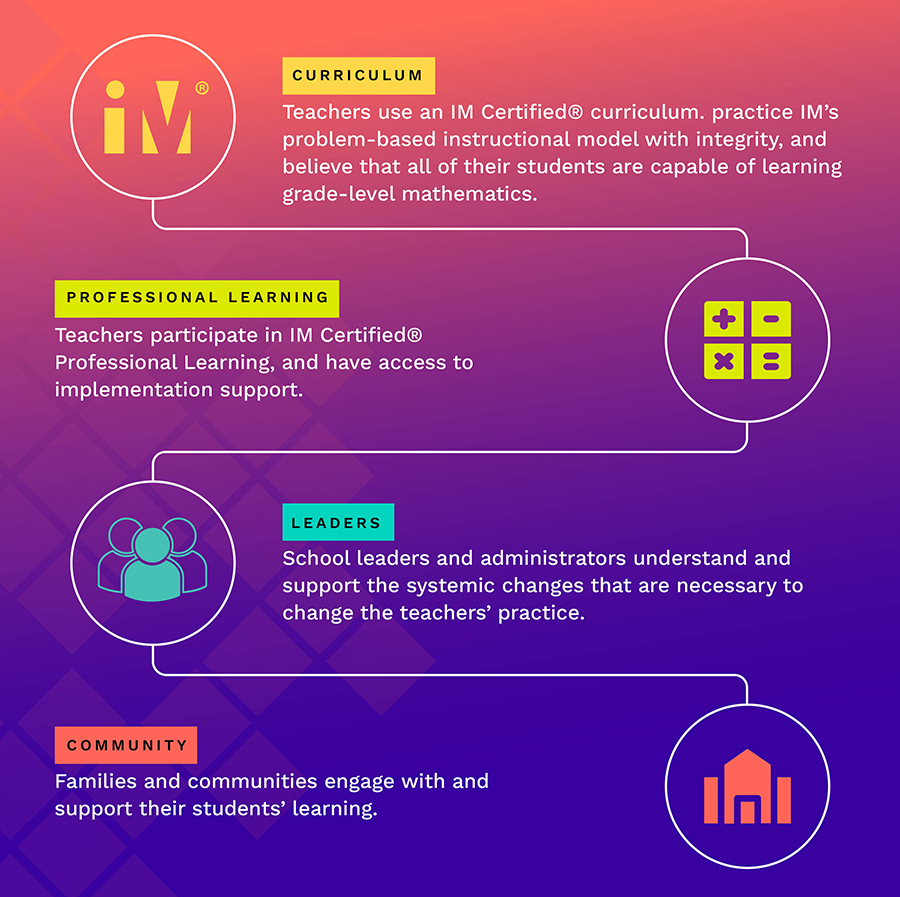By William McCallum, IM CEO
Here at IM we are excited by and proud of the reception IM K–12 Math™ is getting. As more and more districts adopt it, we are thinking about how to support them. What are the next steps? Our vision of a classroom community informs this work. We picture students actively engaged with and excited by the materials, confidently persevering in solving problems and sharing their thinking. We envision the teacher leading productive and meaningful discussions that help synthesize the students’ learning of rigorous grade-level content. How can we make this vision a reality in more schools?
A coherent curriculum, like IM K–12 Math™, is critical to building classroom community, but more is needed to support teachers, schools, and districts with instructional shifts that promote access and equity for all students. There should be a shared vision of what the classroom will look like, and consideration of the support teachers will need. At IM, we call our vision the IM Classroom.
What is the IM Classroom?
IM’s work is anchored in the belief that all students are capable of learning grade-level mathematics. Our curriculum supports a problem-based instructional model, where students are invited to the mathematics through relevant and affirming contexts. This draws on their naturally inquisitive nature, and their experience with the world around them. Problems provide multiple access points and solution paths, making them accessible to students at different points in their learning journey.
Problem-based instruction means believing all students can solve problems on their own and giving them a chance to try. This sets them on a path to developing mathematical identities as learners who can know, use, and enjoy mathematics. When students are engaged in their learning, they develop stronger perseverance and better retention of knowledge.

Four Elements of the IM Classroom
- Teachers use an IM Certified® curriculum. practice IM’s problem-based instructional model with integrity, and believe that all of their students are capable of learning grade-level mathematics.
- Teachers participate in IM Certified Professional Learning, and have access to implementation support.
- School leaders and administrators understand and support the systemic changes that are necessary to change the teachers’ practice.
- Families and communities engage with and support their students’ learning.
Let’s take a closer look at each pillar.
Pillar 1: Implementing problem-based instruction with IM Certified curriculum
IM Classroom teachers are passionate about learning and implementing our problem-based instructional model with integrity. They make sure their students understand each problem, monitor their students’ work and advance their thinking with probing questions, provide information as appropriate, and, importantly, synthesize their students’ learning at the end to make sure the goals of the activity have been met.
In an IM Classroom, the curriculum is obtained from one of our IM Certified Partners or by accessing the free, open educational resource (OER) on our website. IM Certification guarantees alignment with our coherent progressions of concepts and procedures. IM certified solutions include print and online tools, such as instructional videos and digital centers and manipulatives that support teachers to meet the needs of all learners.
Pillar 2: Teachers participate in IM Certified Professional Learning
When professional learning is certified by Illustrative Mathematics, it means that high- quality curriculum-aligned content is delivered by qualified facilitators who undergo rigorous training and ongoing development. IM Certified Professional Learning provides a coherent suite of offerings, both onsite and virtual, that support teachers and leaders through initial adoption and ongoing learning.
IM Certified Professional Learning Facilitators are experts in IM K–12 Math™ and the problem-based instructional model. In the IM Classroom, teachers continue to grow in both their practice and their understanding of the curriculum. Their participation in ongoing professional learning supports these efforts.
Pillar 3: School leaders and administrators understand and support necessary changes
While teachers have a direct impact on students’ learning experiences, school and district leaders play an important role in making sure teachers have the appropriate tools and resources for their students to thrive. For successful implementation of IM K–12 Math™, leaders have a deep understanding of the problem-based instructional model, pedagogical practices, and planning protocols in order to create systems of support.
The IM Classroom exists in a building where school leaders and administrators support teachers and create systemic change through coaching, collaborative planning, implementation, and long-term support. IM Certified Professional Learning offers products and services for building leaders in order to support this effort.
Pillar 4: Families and communities engage with and support student learning
Families are students’ first teachers. At IM, we believe that students should be empowered to recognize and explore math in the world around them, whether they are at school, at home, or in their communities. IM curricular materials include family supports that provide an overview of each unit and interactive mathematical questions that families can ask their children as the unit progresses.
IM is also developing relationships with organizations such as Family Engagement Lab, whose FASTalk (Families and Schools Talk) tool includes families as instructional partners by providing curriculum-aligned learning activities to families via text message in their home language. The IM Classroom honors caregivers as critical stakeholders, which moves everyone towards a collaborative and supportive learning experience.
What happens in an IM Classroom?
When a student enters an IM Classroom, they enter a space that will encourage participation, develop confidence, inspire collaboration, and most importantly, equip them to know, use, and enjoy mathematics. The essence of the IM Classroom is the idea that learning happens when you pay attention to all of the actors—the students, the teachers, and the mathematics (yes, mathematics is alive in the IM Classroom!)—and build an instructional model that supports the complex community that they form.
